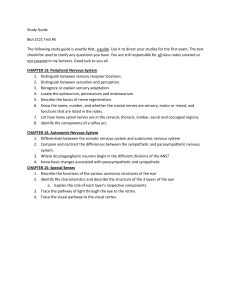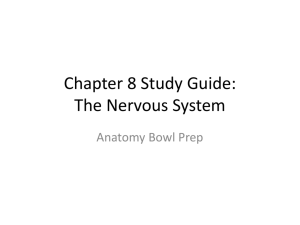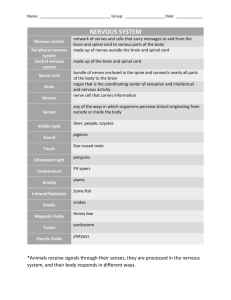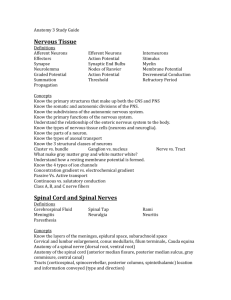THE NERVOUS SYSTEM HEADING VOCABULARY IMPORTANT INFO
advertisement
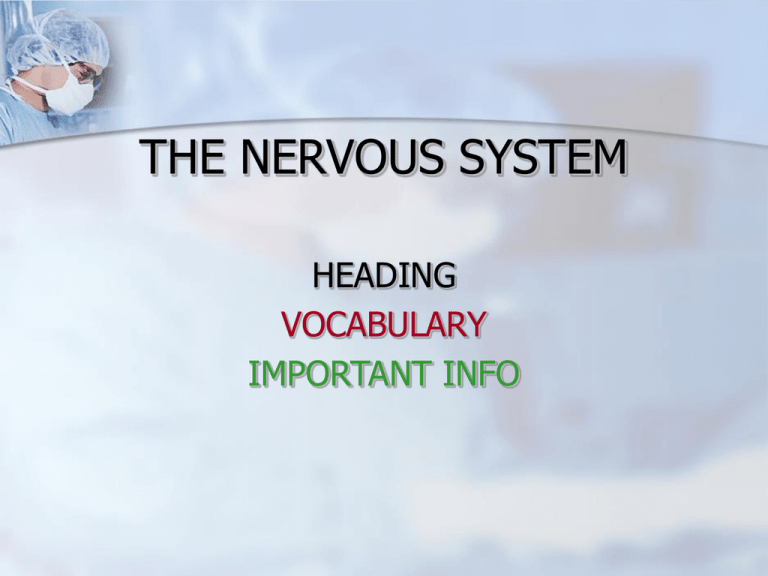
THE NERVOUS SYSTEM HEADING VOCABULARY IMPORTANT INFO Major Structures of the Nervous System Brain, cranial nerves, spinal cord, spinal nerves, ganglia, enteric plexuses and sensory receptors Nervous System Divisions Central nervous system (CNS) consists of the brain and spinal cord Peripheral nervous system (PNS) consists of cranial and spinal nerves that contain both sensory and motor fibers connects CNS to muscles, glands & all sensory receptors Subdivisions of the PNS Somatic (voluntary) nervous system (SNS) neurons from cutaneous and special sensory receptors to the CNS motor neurons to skeletal muscle tissue Autonomic (involuntary) nervous systems sensory neurons from visceral organs to CNS motor neurons to smooth & cardiac muscle and glands sympathetic division (speeds up heart rate) parasympathetic division (slow down heart rate) Enteric nervous system (ENS) involuntary sensory & motor neurons control GI tract neurons function independently of ANS & CNS Neurons Functional unit of nervous system Have capacity to produce action potentials electrical excitability Cell body single nucleus with prominent nucleolus Nissl bodies (chromatophilic substance) rough ER & free ribosomes for protein synthesis Neurofilaments give cell shape and support Microtubules move material inside cell Cell processes = dendrites & axons The basic unit of the nervous system = neuron? Dendrites receive stimuli Nerve cell body @ nucleus transmits the stimuli Axon transmits the impulse to another dendrite Parts of a Neuron Neuroglial cells Nucleus with Nucleolus Axons or Dendrites Cell body Dendrites Conducts impulses towards cell body Typically short, highly branched & unmyelinated Surfaces specialized for contact with other neurons Contains neurofibrils & Nissl bodies Axons Conduct impulses away from cell body Long, thin cylindrical process of cell Impulses arise from initial segment (trigger zone) Side branches (collaterals) end in fine processes called axon terminals Swollen tips called synaptic end bulbs contain vesicles filled with neurotransmitters Functional Classification of Neurons Sensory (Afferent) neurons Motor (Efferent) neurons transport sensory information from skin, muscles, joints, sense organs & viscera to CNS send motor nerve impulses to muscles & glands Interneurons (Association) neurons connect sensory to motor neurons 90% of neurons in the body What is a synapse ? Junction of two neurons Neurotransmitter convert the electrical impulse into a chemical message Axon ending: terminal bud Transfers the electrical nerve impulse By chemical neurontransmitters From one neuron to the next The Action Potential: Summarized Chemical Synapses Action potential reaches end bulb and voltage-gated Ca+ 2 channels open Ca+2 flows inward triggering release of neurotransmitter Neurotransmitter crosses synaptic cleft & binding to receptors the more neurotransmitter released the greater the change in potential of the postsynaptic cell Synaptic delay is 0.5 msec One-way information transfer The Central Nervous System: 1) Spinal Cord 2) Brain medulla for breathing cerebellum for balance cerebrum for higher thinking bw Spinal Cord Protection •By the vertebral column, meninges, cerebrospinal fluid, and vertebral ligaments. External Anatomy of Spinal Cord Flattened cylinder 16-18 Inches long & 3/4 inch diameter In adult ends at L2 In newborn ends at L4 Growth of cord stops at age 5 Cervical enlargement upper limbs Lumbar enlargement lower limbs Spinal Cord & Spinal Nerves Spinal nerves begin as roots Dorsal or posterior root is incoming sensory fibers dorsal root ganglion (swelling) = cell bodies of sensory nerves Ventral or anterior root is outgoing motor fibers Spinal Nerves 31 Pairs of spinal nerves Named & numbered by the cord level of their origin 8 pairs of cervical nerves (C1 to C8) 12 pairs of thoracic nerves (T1 to T12) 5 pairs of lumbar nerves (L1 to L5) 5 pairs of sacral nerves (S1 to S5) 1 pair of coccygeal nerves Mixed sensory & motor nerves The Brain and Cranial Nerves almost 3 lb. Brain functions in sensations, memory, emotions, decision making, behavior Principal Parts of the Brain Cerebrum Diencephalon thalamus & hypothalamus Cerebellum Brainstem medulla, pons & midbrain Medulla Oblongata Continuation of spinal cord Ascending sensory tracts Descending motor tracts Nuclei of 5 cranial nerves Cardiovascular center Respiratory center force & rate of heart beat diameter of blood vessels medullary rhythmicity area sets basic rhythm of breathing Information in & out of cerebellum Reflex centers for coughing, sneezing, swallowing etc One inch long White fiber tracts ascend and descend Pneumotaxic & apneustic areas help control breathing Middle cerebellar peduncles carry sensory info to the cerebellum Cranial nerves 5-7 Pons Midbrain One inch in length Extends from pons to diencephalon Cerebral aqueduct connects 3rd ventricle above to 4th ventricle below Cerebellum 2 cerebellar hemispheres and Vermis (central area) Function correct voluntary muscle contraction and posture based on sensory data from body about actual movements sense of equilibrium Thalamus 1 inch long mass of gray mater in each half of brain (connected across 3rd ventricle by intermediate mass) Relay station for sensory information on way to cortex Crude perception of some sensations Hypothalamus Dozen or so nuclei in 4 major regions mammillary bodies are relay station for olfactory reflexes; infundibulum suspends the pituitary gland Major regulator of homeostasis receives somatic and visceral input, taste, smell & hearing information; monitors osmotic pressure, temperature of blood Functions of Hypothalamus Controls and integrates activities of ANS which regulates smooth, cardiac muscle and glands Synthesizes regulatory hormones that control the anterior pituitary Contains cell bodies of axons that end in posterior pituitary where they secrete hormones Regulates rage, aggression, pain, pleasure & arousal Feeding, thirst & satiety centers Controls body temperature Regulates daily patterns of sleep Epithalamus Pineal Gland endocrine gland the size of small pea secretes melatonin during darkness promotes sleepiness & sets biological clock Habenular Nuclei emotional responses to odors Cerebrum (Cerebral Hemispheres) Cerebral cortex is gray matter overlying white matter 2-4 mm thick containing billions of cells grew so quickly formed folds (Gyri) and grooves (Sulci or Fissures) Longitudinal fissure separates left & right cerebral hemispheres Corpus Callosum is band of white matter connecting left and right cerebral hemispheres Each hemisphere is subdivided into 4 lobes Right versus left Cerebrum Limbic System Emotional brain--intense pleasure & intense pain Strong emotions increase efficiency of memory 2 Types of Nervous Responses? A. Voluntary the brain & spinal cord B. Involuntary or Autonomic System Sympathetic Parasympathetic Somatic Sensory Pathways First-order neuron conduct impulses to brainstem or spinal cord either spinal or cranial nerves Second-order neurons conducts impulses from spinal cord or brainstem to thalamus--cross over to opposite side before reaching thalamus Third-order neuron conducts impulses from thalamus to primary somatosensory cortex (postcentral gyrus of parietal lobe) Somatic Motor Pathways Control of body movement motor portions of cerebral cortex initiate & control precise movements Basal Ganglia help establish muscle tone & integrate semivoluntary automatic movements Cerebellum helps make movements smooth & helps maintain posture & balance Somatic motor pathways direct pathway from cerebral cortex to spinal cord & out to muscles indirect pathway includes synapses in basal ganglia, thalamus, reticular formation & cerebellum The Autonomic Nervous System Regulate activity of smooth muscle, cardiac muscle & certain glands Structures involved general visceral afferent neurons (Sensory) general visceral efferent neurons (Motor) integration center within the brain Receives input from limbic system and other regions of the cerebrum The Autonomic Nervous System Autonomic versus Somatic NS •Autonomic NS –unconsciously perceived visceral sensations –involuntary inhibition or excitation of smooth muscle, cardiac muscle or glandular secretion –2 neurons needed to connect CNS to organ –Preganglionic and Postganglionic neurons Somatic NS consciously perceived sensations excitation of skeletal muscle one neuron connects CNS to organ Autonomic versus Somatic NS Notice that the ANS pathway is a 2 neuron pathway while the Somatic NS only contains one neuron. Divisions of the ANS 2 major divisions Parasympathetic Sympathetic Dual innervation (2 nerve supplies) 1 speeds up organ 1 slows down organ Sympathetic NS increases heart rate Parasympathetic NS decreases heart rate Sympathetic Responses Dominance by the sympathetic system is caused by physical or emotional stress – exercise Alarm Reaction = Flight or Fight Response “E situations”: emergency, embarrassment, excitement, dilation of pupils, increase of heart rate, force of contraction & BP decrease in blood flow to nonessential organs increase in blood flow to skeletal & cardiac muscle airways dilate & respiratory rate increases blood glucose level increase Long lasting due to lingering of NE in synaptic gap and release of norepinephrine by the adrenal gland Parasympathetic Responses Enhance “Rest-and-Digest” activities Mechanisms that help conserve and restore body energy during times of rest Normally dominate over sympathetic impulses SLUDD Type Responses = salivation, lacrimation, urination, digestion & defecation and 3 “decreases”--decreased HR, diameter of airways and diameter of pupil Paradoxical Fear when there is no escape route or no way to win causes massive activation of parasympathetic division loss of control over urination and defecation Control of Autonomic NS Not aware of autonomic responses because control center is in lower regions of the brain Hypothalamus is major control center Input: emotions and visceral sensory information smell, taste, temperature, osmolarity of blood, etc Output: to nuclei in brainstem and spinal cord posterior & lateral portions control sympathetic NS increase heart rate, inhibition GI tract, increase temperature anterior & medial portions control parasympathetic NS decrease in heart rate, lower blood pressure, increased GI tract secretion and mobility



